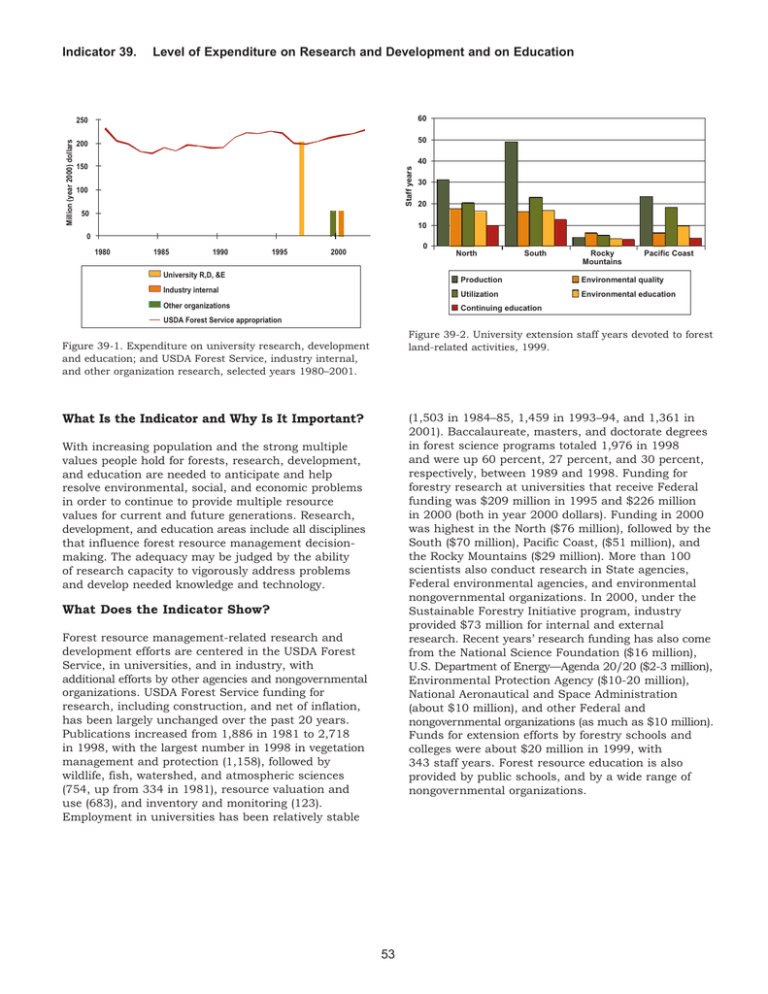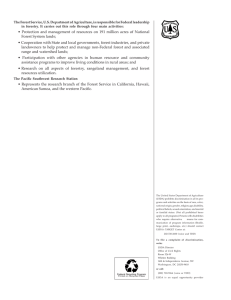Indicator 39.
advertisement

Level of Expenditure on Research and Development and on Education 250 60 200 50 40 150 Staff years Million (year 2000) dollars Indicator 39. 100 30 20 50 10 0 1980 1985 1990 1995 0 2000 North University R,D, &E Industry internal Other organizations South Rocky Mountains Pacific Coast Production Environmental quality Utilization Environmental education Continuing education USDA Forest Service appropriation Figure 39-2. University extension staff years devoted to forest land-related activities, 1999. Figure 39-1. Expenditure on university research, development and education; and USDA Forest Service, industry internal, and other organization research, selected years 1980–2001. What Is the Indicator and Why Is It Important? (1,503 in 1984–85, 1,459 in 1993–94, and 1,361 in 2001). Baccalaureate, masters, and doctorate degrees in forest science programs totaled 1,976 in 1998 and were up 60 percent, 27 percent, and 30 percent, respectively, between 1989 and 1998. Funding for forestry research at universities that receive Federal funding was $209 million in 1995 and $226 million in 2000 (both in year 2000 dollars). Funding in 2000 was highest in the North ($76 million), followed by the South ($70 million), Pacific Coast, ($51 million), and the Rocky Mountains ($29 million). More than 100 scientists also conduct research in State agencies, Federal environmental agencies, and environmental nongovernmental organizations. In 2000, under the Sustainable Forestry Initiative program, industry provided $73 million for internal and external research. Recent years’ research funding has also come from the National Science Foundation ($16 million), U.S. Department of Energy—Agenda 20/20 ($2-3 million), Environmental Protection Agency ($10-20 million), National Aeronautical and Space Administration (about $10 million), and other Federal and nongovernmental organizations (as much as $10 million). Funds for extension efforts by forestry schools and colleges were about $20 million in 1999, with 343 staff years. Forest resource education is also provided by public schools, and by a wide range of nongovernmental organizations. With increasing population and the strong multiple values people hold for forests, research, development, and education are needed to anticipate and help resolve environmental, social, and economic problems in order to continue to provide multiple resource values for current and future generations. Research, development, and education areas include all disciplines that influence forest resource management decisionmaking. The adequacy may be judged by the ability of research capacity to vigorously address problems and develop needed knowledge and technology. What Does the Indicator Show? Forest resource management-related research and development efforts are centered in the USDA Forest Service, in universities, and in industry, with additional efforts by other agencies and nongovernmental organizations. USDA Forest Service funding for research, including construction, and net of inflation, has been largely unchanged over the past 20 years. Publications increased from 1,886 in 1981 to 2,718 in 1998, with the largest number in 1998 in vegetation management and protection (1,158), followed by wildlife, fish, watershed, and atmospheric sciences (754, up from 334 in 1981), resource valuation and use (683), and inventory and monitoring (123). Employment in universities has been relatively stable 53



